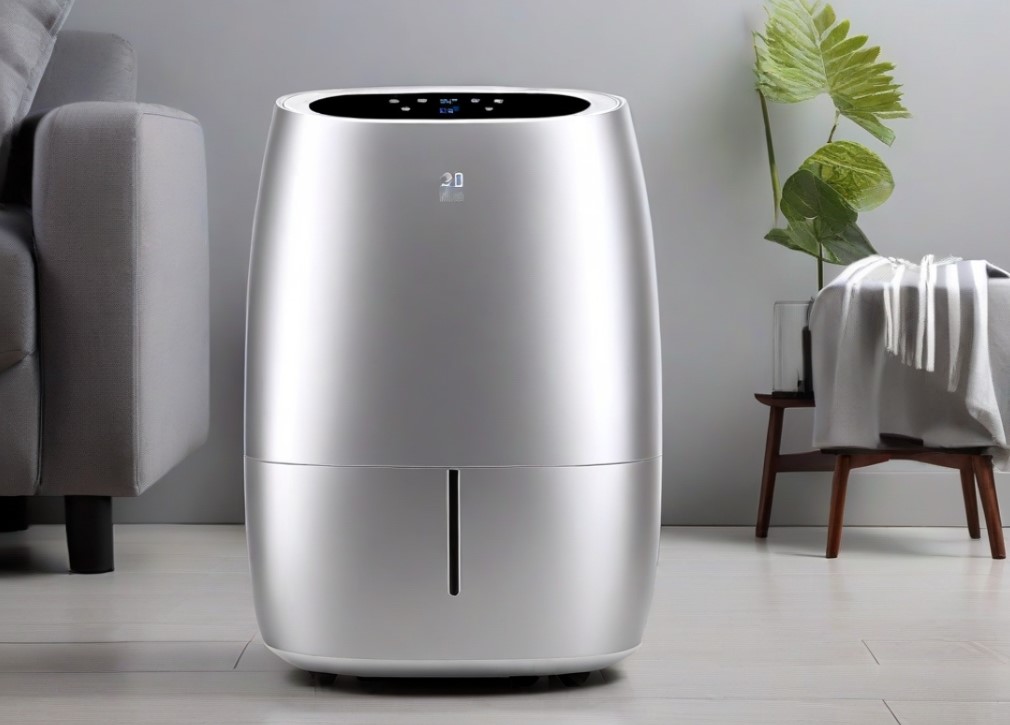With New Zealand’s damp climate, dealing with excess moisture in homes can be an ongoing battle. From mold and mildew growth to stuffiness and musty odors, high humidity levels can create any number of problems. This is where a dehumidifier can be an extremely useful appliance to have on hand.
Dehumidifiers work by drawing moist air into the unit, condensing the excess moisture out, and expelling drier air back into the room. This helps regulate humidity for a more comfortable environment. But with so many options on the market, how do you determine which dehumidifier is right for your needs and New Zealand conditions?
In this blog post, we’ll break down the top-rated dehumidifiers readily available to Kiwi households. We’ve researched the latest models and brands to provide key information on factors like capacity, coverage area, energy efficiency, and extra features. Whether you need a dehumidifier for a single room or a whole house, our guide covers a range of compact portable units perfect for apartments to larger capacity dehumidifiers capable of handling damp basements or crawl spaces.
Table of Contents
How to choose the Best Dehumidifier for you
To choose the best dehumidifier for your needs, it is important to consider several factors that will influence its performance and suitability for your space. Below are key points to consider before buying the best dehumidifier.
What are the different types of dehumidifiers?
There are three distinct dehumidifier types available, each offering unique features that cater to various home environments and activities. Here they are:
Compressor Dehumidifiers:
Compressor dehumidifiers, also known as refrigerant dehumidifiers, are the most common type used in homes and commercial spaces. They work by drawing moist air over a refrigerated coil with a fan. The cold coil causes the moisture in the air to condense into water which is then collected in a container or drained away. A second, warmer coil re-heats the air to room temperature before it is released back into the room.
These units can extract anywhere from less than 10 liters to over 50 liters per day, depending on the model and the conditions (like temperature and humidity level). Compressor dehumidifiers are most effective at higher ambient temperatures and higher humidity levels since colder air holds less moisture and may not condense as readily on the cooling coils.
Pros:
- High moisture removal rate, suitable for large areas and high humidity conditions.
- Generally cost-effective in terms of the amount of moisture they can remove.
- Wide range of sizes to fit different spaces.
- Many models come with additional features like humidistats, timers, and auto shut-off.
Cons:
- Can be noisy due to the compressor and fan.
- Less energy-efficient in cooler temperatures since they rely on a differential in temperature to condense moisture.
- Heavier and bulkier than other types, making them less portable.
- Not as effective in cold environments because the coils can freeze.
Peltier Dehumidifiers:
Peltier dehumidifiers, known as thermo-electric dehumidifiers, use a Peltier pump to create a cool surface for condensing the moisture from the air. They operate silently compared to compressor dehumidifiers, as they have no moving parts except for the fan. However, these units are typically less energy-efficient and are most suitable for small spaces or areas where the noise level needs to be kept to a minimum. The moisture removal capacity of these dehumidifiers is much less than compressor-based units, often less than 2 liters per day.
Pros:
- Very quiet operation, ideal for bedrooms, offices, and areas where noise is a concern.
- Compact size, making them highly portable and suitable for small spaces.
- Low power consumption.
- Minimal maintenance is required.
Cons:
- Limited moisture removal capability, generally only suitable for small areas.
- Slower operation and less efficient in terms of energy consumption per liter of water removed.
- Not suitable for high humidity environments or larger rooms.
Desiccant Dehumidifiers:
Desiccant dehumidifiers use a desiccant material, which is a substance that naturally absorbs moisture, such as silica gel. Air is passed over the desiccant material where it is dehumidified and then reheated before being discharged back into the room. The dehumidified water collected in the desiccant is then removed, often by heating the material so that it releases the moisture, which is then condensed and collected.
This type of dehumidifier can work effectively at lower temperatures and lower humidity levels, unlike compressor dehumidifiers. Desiccant dehumidifiers range in size and moisture extraction rate, from small units for domestic use to large industrial models that can remove hundreds of liters per day.
Pros:
- Effective at low temperatures, making them suitable for basements, garages, and colder climates.
- Can operate at a wider range of temperatures and humidity levels.
- Often quieter than compressor dehumidifiers since there’s no compressor.
- Some models are designed to be more energy-efficient, especially when it’s cold.
Cons:
- The desiccant material needs to be replenished or replaced over time, which can be an ongoing cost.
- Some models, especially those that heat the desiccant for moisture removal, can consume a lot of energy.
- Larger desiccant models can be expensive and may require professional installation.
Whole-House Dehumidifiers:
Whole-house dehumidifiers are integrated into the HVAC system of a home or building and work in conjunction with the heating and cooling system to control humidity levels in the entire space. They’re typically more powerful and efficient than portable units, with moisture extraction capacities that can exceed 25-30 liters per day. Installation requires professional HVAC knowledge, and such systems are ideal for maintaining a consistent humidity level throughout a large space.
Pros:
- Centralised control of humidity for the entire home or building.
- High capacity and efficient at moisture removal.
- Can improve the overall air quality and comfort.
- Often integrates with existing HVAC systems for seamless operation.
Cons:
- Expensive initial installation and potential modification to existing HVAC systems.
- May require professional maintenance.
- Not practical for apartments or rented spaces due to the installation requirements.
Mini Dehumidifiers:
Mini dehumidifiers are compact units designed for small, enclosed spaces such as closets, bathrooms, and pantries. They often use Peltier technology or small amounts of desiccant materials. Their small size and low power consumption make them ideal for addressing humidity issues in targeted areas. These dehumidifiers typically have a very low water extraction capability, usually less than a liter per day, due to their small size.
Pros:
- Compact and highly portable, ideal for small and enclosed spaces.
- Inexpensive and low power usage.
- Very quiet operation, suitable for bedrooms and nurseries.
- Simple to use, with minimal maintenance.
Cons:
- Very limited water extraction capability, not for medium to large rooms.
- May need frequent emptying due to small water tanks.
- Not effective in areas with high levels of humidity.
- Lifespan may be shorter compared to more robust units.
What size dehumidifier do you need?
It’s important to be aware of the unique climate factors that might influence your decision. New Zealand’s climate ranges from humid on the North Island to drier in some parts of the South Island. The insulation and heating in your home may also affect your needs. Here’s how you can determine the right size dehumidifier for your needs:
Use the following guidelines, which can be adapted to fit metric measurements:
Mildly Damp (Feels damp and has a musty smell in humid weather):
- 10-12 liters per day for up to 50 square meters
- 12-15 liters per day for up to 100 square meters
Moderately Damp (Space always feels damp and has a musty smell; damp spots may show on walls and floor):**
- 14-18 liters per day for up to 50 square meters
- 18-22 liters per day for up to 100 square meters
Very Damp (Space feels constantly wet, smells musty, walls or floor sweat, or seepage is present):
- 20-25 liters per day for up to 50 square meters
- 25-30 liters per day for up to 100 square meters
Consider Room Conditions: Bathrooms, kitchens, and laundry areas in your homes often have higher humidity levels and may require more robust dehumidifiers. Basements and poorly insulated areas may be cooler, which could affect the efficiency of compressor dehumidifiers—consider a desiccant model in such cases.
Account for Load Factors: Large families, indoor drying of clothes, and frequent cooking can add to the humidity in the home. Spaces with plants or unventilated areas may also require a larger dehumidifier
What other features do you need to look for?
In addition to choosing the right size or capacity for your space, there are numerous other features and factors to consider that can greatly improve usability, effectiveness, and convenience. Here are the essential features to keep in mind:
Dehumidifier Capacity: The capacity of a dehumidifier is one of the most critical aspects to consider. It’s typically measured by the amount of moisture the device can remove from the air in 24 hours and is usually quantified in liters. Residential dehumidifiers can range anywhere from a few liters to over 50 liters per day. For industrial or commercial-use dehumidifiers, the capacity can exceed even this range considerably.
Water Tank Capacity: The water tank capacity is the volume of water that the dehumidifier can hold before it needs to be emptied. This capacity typically ranges from around 1 liter to over 6 liters in portable residential units. The right tank size for you will depend on the dehumidifier’s capacity, the humidity level of the room, and how often you are able to empty the tank. If the tank is too small relative to the dehumidifier’s capacity and the room’s humidity, you may need to empty it frequently, which can be inconvenient. Some dehumidifiers offer a continuous drainage option to bypass the need for emptying the tank, which is useful for higher-capacity units or for when the unit is used in very high-humidity conditions.
Air Filtration Capability: Many modern dehumidifiers come with air filtration capabilities, which enhance air quality by trapping dust and other airborne particles. These filters can be basic, designed to catch larger particles and protect the dehumidifier’s internals, or they may be more advanced, like HEPA filters that can remove smaller particulates and improve the air quality significantly.
Filters in dehumidifiers can also mitigate allergens such as pollen, pet dander, and dust mites. It’s important to regularly maintain or replace these filters to ensure effective air filtration and prevent any reduction in the dehumidification performance.
Humidity Control: Accurate humidity control allows you to maintain your ideal climate within a space. This is often facilitated through a built-in humidistat, which detects the relative humidity of your room and adjusts the dehumidifier’s operation accordingly. You can set a specific humidity level, often recommended between 30% and 50% for comfort and health, and the device will cycle on and off to maintain it
Precise humidity control is not just a matter of comfort; it also contributes to the longevity of your home and belongings by preventing mold, mildew, and other moisture-related issues. High-quality dehumidifiers allow you to control the humidity levels with a high degree of accuracy and may also display the current humidity level on an LCD panel.
Adjustable Fan Speeds: Multiple fan speeds give you control over the rate at which the dehumidifier pulls in air. Higher speeds can dehumidify quicker, while lower speeds are quieter and more energy-efficient.
Noise Level: Some dehumidifiers can be noisy. Pay attention to the noise level, typically measured in decibels (dB), if you are sensitive to sound or plan to use it in noise-sensitive areas like bedrooms or study rooms.
Portability: If you plan to move the dehumidifier between rooms, look for features that enhance portability, such as caster wheels, carrying handles, and lightweight construction.
Filter Indicator: Most dehumidifiers come with air filters that need periodic cleaning or replacement. A filter indicator will alert you when it’s time to clean or change the filter to ensure the unit runs efficiently.
Auto-Reset: In the event of a power outage, an auto-reset function will restart the dehumidifier with the previous settings once power is restored.
Timer: A timer lets you program the dehumidifier to turn on or off at specific times, which can help save energy when the space is unoccupied.
READ NEXT: Best Tumble Dryers | Heaters | Electric Blankets | Air Purifiers
The Best Dehumidifiers NZ
1. Smart Ape Desiccant Dehumidifier
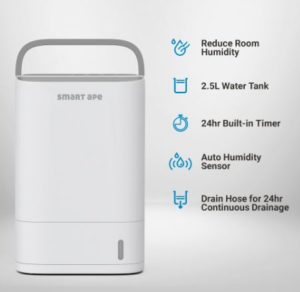
The Smart Ape 7L Desiccant Dehumidifier excels in maintaining a comfortable moisture level in areas up to 40m². Its quiet operation ensures that it does not disrupt your daily life while efficiently trapping moisture. With three diverse modes, it caters to various needs, including an efficient setting for drying clothes.
Integration with the Smart Life app brings convenience, allowing users to schedule dehumidification cycles from their smartphones. The added Wi-Fi connectivity means you can control the device remotely, ensuring your home’s humidity is managed even while you’re away. The 90° adjustable oscillation and the 8-hour timer grant further personalization, letting you optimize the unit’s operation to suit your schedule.
Safety is a notable feature of the Smart Ape Desiccant Dehumidifier, with a tip-over protection that automatically switches off the unit if it’s not upright. The robust dehumidification rate of 6L per day highlights its effectiveness, making it a reliable option for keeping your living space dry and comfortable.
2. Panasonic Dehumidifier
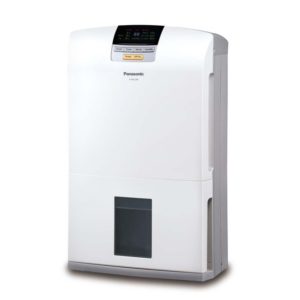
The Panasonic Dehumidifier provides an efficient solution to moisture control, boasting a significant 17 litres per day extraction ability. Its spacious 4.8-litre water tank means fewer trips to empty it, and the unit is engineered to combat mold growth, making your home a healthier environment.
User-friendliness is at the core of its design, with an auto-dehumidify mode that adjusts to your preferred settings, and a front panel that allows for fine-tuning of humidity levels. The ease of emptying and maintaining this dehumidifier is a standout benefit. Additionally, the laundry drying mode adds a layer of functionality, doubling up as a quick drying aid for clothes.
For those needing tailored dehumidifying schedules, the flexible 2/4/8 hour timer fits into any routine seamlessly. Plus, there’s an option for a larger 33L capacity model, ensuring that homes of all sizes can find their perfect match with Panasonic’s dehumidifier range.
3. Fraser Country Mini Dehumidifier
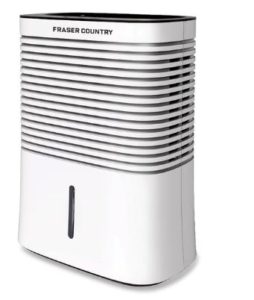
The Fraser County Mini Dehumidifier is a compact, cost-effective choice for those looking to tackle high humidity in smaller areas. Its considerable tank capacity for sustained operation and an auto shut-off mechanism ensures safety and prevents overflow, providing peace of mind.
This mini dehumidifier not only maintains a dry environment but also combats condensation effectively, addressing mold issues and musty odors. The benefits extend to your health by minimizing potential irritation to your skin and respiratory system commonly associated with damp conditions.
With user convenience in mind, the Fraser County Mini Dehumidifier offers 4 and 8-hour timer controls, allowing you to manage operation times according to your daily schedule. This makes it a practical and simple solution for maintaining a comfortable humidity level at home.
4. Philips 2-in-1 Air – DE5205
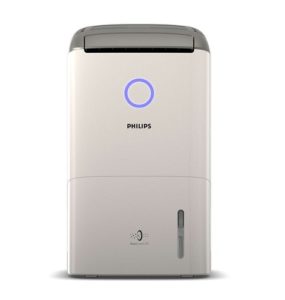
The Philips 2-in-1 Air Dehumidifier stands out with its dual functionality, offering both superior dehumidification and advanced air purification. The sleek white design with a metallic black touch control panel and a durable plastic body material makes it an elegant addition to any room.
Ease of use is central to its design, featuring a digital humidity sensor and automatic dehumidification control that adjusts to pre-set levels ranging from 40% to 80%, ensuring your room maintains a comfortable humidity. Tailor the environment to your preference with these customizable settings.
Not just for dehumidifying, it boasts a Special dry laundry mode for efficient clothes drying. The Continuous dry mode is engineered to provide a stable environment, safeguarding against pollutants and allergens, thus promoting a healthier living space. Additional conveniences include 5 fan speeds for varying conditions, an airlock for easy filter replacement, and an alert system that notifies you when the tank is full.
5. Midea FreshDry Dehumidifier
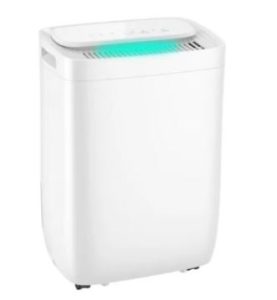
The Midea FreshDry Dehumidifier is a compact yet robust tool for controlling humidity in spaces up to 35 square meters. Weighing a mere 12 kg, its portability makes it suitable for maneuvering around the home wherever it’s needed most. With the ability to extract up to 12 liters of moisture daily, it’s a powerful ally against the dampness in moisture-prone rooms.
A 1.6-liter water tank ensures adequate storage, minimizing the need for frequent emptying. The integration of a HEPA filter signifies this model’s commitment to air quality, capturing fine particles for a cleaner breathing environment. The added convenience of WiFi connectivity puts humidity control at your fingertips, allowing for remote monitoring and management through your smart device.
For larger spaces, Midea offers a more substantial option with a 50 liters per day capacity and a generous 6-liter water tank, making it suitable for significant moisture challenges. Whether for a compact studio or an expansive living area, the Midea FreshDry range adapts to diverse needs, providing effective dehumidification with the bonus of enhanced air purification.
6. Dimplex GDDE25E
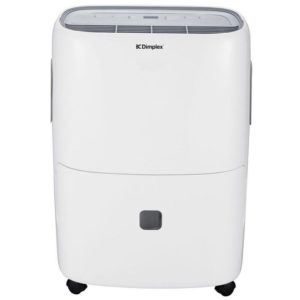
The Dimplex Portable Dehumidifier presents a sleek, freestanding design in a subtle grey and white finish, seamlessly blending into any room decor. Its ample 3.5-liter tank capacity paired with a robust moisture removal rate of 25 liters per day ensures a significant impact on air quality and humidity levels, signaled by a useful tank full indicator.
Operation is a breeze with its electronic control, offering adjustable humidity settings ranging from 30% to 80% relative humidity. The digital display enhances user interaction, providing easy access to select from its three pre-set modes tailored for continuous operation, living rooms, or bedrooms, catering to different needs and comfort levels.
Despite its power, rated at 350W, efficiency is maintained with a 24-hour timer that adds convenience and control over energy consumption. The unit is further enhanced with practical features such as auto defrost, continuous drainage for uninterrupted operation, and a filter wash reminder, maintaining optimal performance. At 53dB(A), its noise level is comparable to moderate ambient noise, ensuring that dehumidification is felt and not heard.
7. Ausclimate Dehumidifier
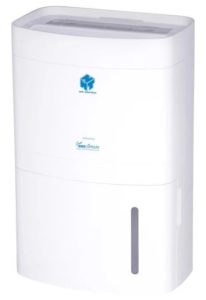
The Ausclimate Medium Room Dehumidifier is an excellent fit for smaller spaces, effectively servicing areas up to 30 square meters or 75 cubic meters. Its capacity to remove 20 liters of moisture per day makes it a popular choice among those living in medium-sized rooms seeking to combat excess humidity.
Ease of use is a highlight with this unit’s fully electronic controls and clear LCD display, simplifying the dehumidification process for users. It’s perfectly sized to integrate into master bedrooms and other average-sized living spaces without being obtrusive.
Notable convenience features include the capacity for 20L of moisture extraction over 24 hours, housed in a medium-sized 3.5L water tank. The auto-restart function post-power failure and an automatic shut-off when the tank is full provide peace of mind. Additionally, the dehumidifier boasts dual fan speeds, auto defrost for low-temperature operation, and is equipped with sturdy caster wheels and handles for mobility within the home.
8. Delonghi AriaDry Pure
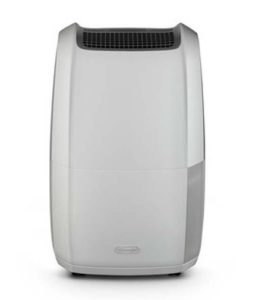
This dehumidifier can significantly improve the comfort and health of your living space. Extracting excess moisture minimizes risks like mould growth, furniture damage, kitchen condensation, bathroom dampness, and unpleasant odors, and is even useful for indoor laundry drying.
To get started, simply position your dehumidifier in an optimal location, and hit the on-off button, followed by the dehumidification button to commence operation. If you’re looking to adjust the room’s humidity, the interactive display lets you cycle through settings, from a very dry 30% up to a more humid 70%, tailoring the environment to your preference.
The unit’s dedicated dry mode is a boon for laundry days, operating at full capacity to expedite the drying process, up to 50% faster than traditional air drying. Enhance air distribution by adjusting the louvre and selecting the desired ventilation speed to circulate dry air throughout the room more effectively, ensuring your laundry dries evenly and quickly.
9. Goldair Dehumidifier
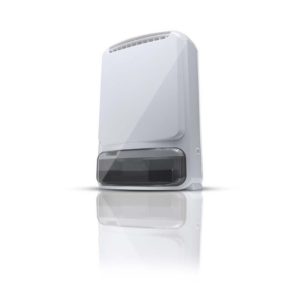
The Goldair Desiccant Dehumidifier shines in its versatility, adept at maintaining comfortable humidity levels in small to medium-sized spaces, and it’s functional in a wide range of temperatures from 0-35 degrees. Its operational range ensures effectiveness across varying climates and seasons, making it a reliable choice for consistent indoor comfort.
By keeping the humidity in check, the dehumidifier plays a crucial role in sustaining a healthy living environment. It actively combats bacteria growth and mould, which are particularly problematic during colder months. As it aids in drying out damp areas, it inadvertently makes heating your home more efficient, contributing to a warmer and more inviting atmosphere.
User convenience is at the heart of this dehumidifier’s design. It boasts an intelligent automatic shut-off system, eliminating worries about energy waste or safety hazards overnight. The inclusion of a 2.0L water tank, automatic defrost, and a self-regulating humidistat means it requires minimal oversight while keeping your space at the optimal humidity level without any fuss.
10. Mitsubishi Electric Oasis Slimline
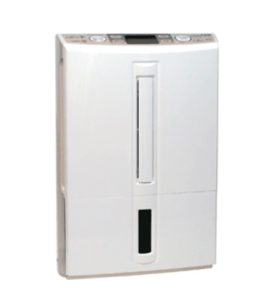
The Mitsubishi Electric Oasis Slimline Dehumidifier is engineered to enhance comfort with its ability to expertly manage the moisture levels in your home. With an ample 4-litre water tank and an intuitive one-touch control panel, this unit is both user-friendly and efficient in moisture removal, capable of extracting up to 16L per day.
What sets this dehumidifier apart is its thoughtful features, which include seven operational modes tailored to different needs and excellent performance in lower temperatures. The inclusion of a washable air purifying filter and mildew guard underscores its commitment to a healthier living space, while the laundry drying mode with a 12-hour timer adds a practical twist, especially on rainy days or for those without a traditional dryer.
For those who value serenity, the Mitsubishi Electric Oasis excels with its whisper-quiet operation. It won’t disrupt your sleep or daily activities, making it an ideal companion for any time of day. Its compact design doesn’t compromise its suitability for larger areas, and the adjustable 1-9 hour timer allows for precise control over its operation, ensuring this dehumidifier is both a subtle and effective addition to any room.
FAQs
Which type of dehumidifier is most efficient?
Desiccant dehumidifiers are highly efficient in colder climates, while compressor-based dehumidifiers are better for high humidity and warmer temperatures.
How do I maintain a dehumidifier?
Maintaining a dehumidifier involves regularly cleaning or replacing filters, emptying the water tank, ensuring airways aren’t blocked, and periodically wiping the interior.
Do dehumidifiers stop mould?
Dehumidifiers can prevent mould by reducing moisture, but they do not kill existing mould. Proper humidity levels must be sustained to keep mould at bay.
Is it better to run a dehumidifier at night or day?
It’s often better to run a dehumidifier during the day because humidity levels are higher, and you can avoid potential noise disturbance at night.
